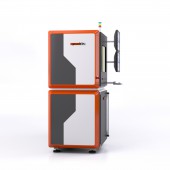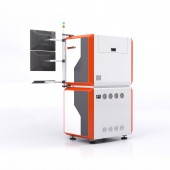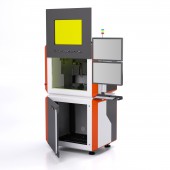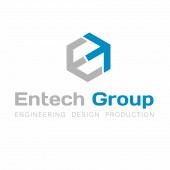Femtika Nanofactory Laser 3D Workstation by Entech Group UAB |
Home > Winners > #87521 |
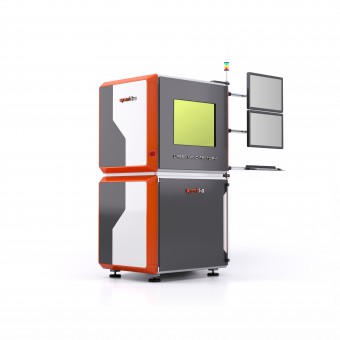 |
|
||||
| DESIGN DETAILS | |||||
| DESIGN NAME: Femtika Nanofactory PRIMARY FUNCTION: Laser 3D Workstation INSPIRATION: Our company got task to design housing for laser equipment. As our team is familiar with those type of devices, we knew how to make design and where to start. I analyzed many competitors and came up with innovative, modern design and construction solutions together with help of engineers. I tried to make it modern looking and original. I took orange color as main accent to accomplish modern style curved lines. The main aim was to design fresh looking, clean shape device that will be the company's flagship. UNIQUE PROPERTIES / PROJECT DESCRIPTION: Laser workstation is made from two separate modules. The bottom part holds laser's control system, computers, and upper part holds femtosecond laser device. Front door goes up and slides down automatically, just by pressing a button. Side covers are lightweight and removable in order to easily serve the device. All system is designed for customer to modify it according to specific needs and requirements. Device has mounting system for two monitors and keyboard in order to easily operate the system. OPERATION / FLOW / INTERACTION: Workstation is made for building very tiny microscopic structures. Laser Nanofactory is perfect for producing high-resolution 3D microstructures using polymers, metals, glass; integration of nano-structures into existing micro- or macro-structures. The new device has very good cooling system, automatic doors save space inside laboratories, the unit can be easily served and has many features which allows to work faster. Device also can be easily modified, it can be used without lower part, just on vibration less table. PROJECT DURATION AND LOCATION: Design and engineering started in 2017 and ended in 2019. Serial roduction is ongoing, for the mid of 2019 we have already made 7 devices and sold to customers from United Kingdom, Germany and Lithuania. Engineering, design and manufacturing process took place in Vilnius, Lithuania. |
PRODUCTION / REALIZATION TECHNOLOGY: First, prototype was made of bent metal sheets. Serial device internal structure is very solid, made from stainless steel tubes welded together. All exterior covers are made from aluminum combined with stainless steel. Grey and white steel sheets were bent, orange aluminum parts were CNC milled and later all assembled together. All parts are panted by powder coating. Bottom part has wheels with fixation mechanism. Automatic doors has a glass which is laser light-proof. Most of screws are hidden, in order to keep clear shape design. SPECIFICATIONS / TECHNICAL PROPERTIES: Product dimensions: 916 x 1144 x 2249 mm. Weight without laser equipment is about 280 kg. Lower part has doors, which is easily opened in order to access control computer. Upper part has vibration less bottom, made from special granite, which is used to keep laser without any vibration from environment. Also, upper part has cooling system with ventilators installed in rear panel. Inside there is led lightening. Device is hermetic ensuring that no dust can be let inside. TAGS: (laser), (industrial), (high accuracy), (metal structure), (research), (laboratory), (machine), (modern), (nanofactory) RESEARCH ABSTRACT: We were working together with client's team in order to learn more about device working principles. We studied some analog devices, learned how to improve the operation, design and servicing. We had many discussions, meetings, tests and conversations with scientists, laser engineers and other potential clients. At first, prototype was made, we tested prototype for 3 months, how it works, where are weak points of construction, and after that, serial production started. CHALLENGE: The main challenge was to make user friendly device, that will have ability to be modified according to user needs. One of the biggest challenges was hide most of screws and rivets, that could not be seen. Also big challenge was to design the shapes that could be made from sheet metal, because not all shapes could be bent from sheets, so we added cnc milling for some external parts. ADDED DATE: 2019-06-18 10:54:21 TEAM MEMBERS (3) : Karolis Bakūnas- designer, Alvydas Vildzevičius- engineer and Lukas Kelevišius- manager IMAGE CREDITS: Image No :1 Designer Karolis Bakūnas, Femtika Workstation, 2019 Image No :2 Designer Karolis Bakūnas, Femtika Workstation, 2019 Image No :3 Designer Karolis Bakūnas, Femtika Workstation, 2019 Image No :4 Designer Karolis Bakūnas, Femtika Workstation, 2019 Image No :5 Designer Karolis Bakūnas, Femtika Workstation, 2019 |
||||
| Visit the following page to learn more: https://bit.ly/2mQoYqF | |||||
| AWARD DETAILS | |
 |
Femtika Nanofactory Laser 3d Workstation by Entech Group Uab is Winner in Prosumer Products and Workshop Equipment Design Category, 2019 - 2020.· Read the interview with designer Entech Group UAB for design Femtika Nanofactory here.· Press Members: Login or Register to request an exclusive interview with Entech Group UAB. · Click here to register inorder to view the profile and other works by Entech Group UAB. |
| SOCIAL |
| + Add to Likes / Favorites | Send to My Email | Comment | Testimonials | View Press-Release | Press Kit |
Did you like Entech Group Uab's Equipment Design?
You will most likely enjoy other award winning equipment design as well.
Click here to view more Award Winning Equipment Design.


